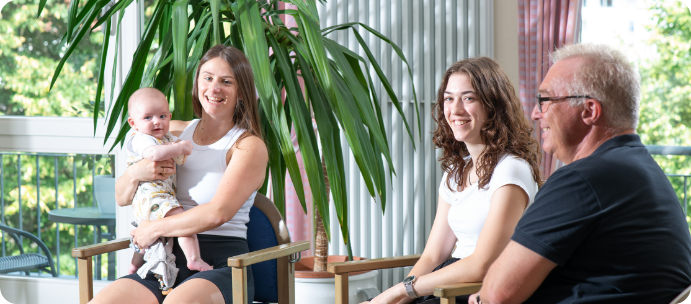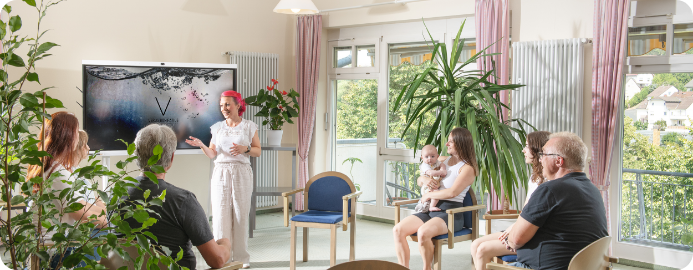
MARTE MEO®
AT THE VERUS BONIFATIUS CLINICWHAT DOES THERAPY OR COUNSELLING ACCORDING TO THE MARTE MEO® METHOD MEAN?
Marte Meo® is derived from Latin and means “By one’s own power”. The method is consistently resource- and development-oriented, which means that the persons concerned are invited to perceive their own abilities and to develop them further with individual support.
Marte Meo® therapy or counselling describes a therapeutic or counselling individual treatment. Very short video recordings (3-5 minutes) from the everyday life of the persons concerned are used. The persons make the previously agreed recordings themselves and hand them over to the specially trained Marte Meo® therapist.
Through a so-called interaction analysis of the video material, the current state of development of communication becomes clear, which can be positively changed through subsequent appointments in the course of an individually tailored process.


WHEN IS THERAPY OR COUNSELLING USING THE MARTE MEO® METHOD RECOMMENDED?
A Marte Meo® therapy or counselling process generally aims at better successful interactions in the everyday life of the persons concerned.
The individual steps of the video-based method serve above all to perceive already existing elements of one’s own communicative behaviour, which have so far been applied rather intuitively. The development of other skills in interactions are also often important, e.g. extended parental communication skills.
Even if children already show behavioural problems, specially trained Marte Meo® professionals can use the video recordings to make the child’s developmental message behind the conspicuous behaviour visible.
For the therapy or counselling process, individual suitable sequences are always selected from the recordings in advance, with which concrete feelings, needs and the currently observable way of dealing with them can be shown and discussed.
The Marte Meo® process continuously builds on the conscious perception of successful moments and the corresponding information about the developmental psychological connections of relationship, attachment and autonomy using concrete recordings of one’s own child. In each appointment, there is an intensive exchange about the respective contents with the persons concerned, including the pictures.
At the same time, Marte Meo® also supports the development of successful communication in various phases of life and situations.
Wherever people communicate with each other, be it at home, at school or at work, Marte Meo® communication skills contribute to an appreciative interaction.
HOW DID THE MARTE MEO® METHOD COME ABOUT?

Maria Aarts founded the Marte Meo® method over 40 years ago.
Since then, “development under one’s own steam” at one’s own pace and from one’s own potential has been the focus of all considerations.
For more than 20 years, the method has been a valued practice-oriented component in childhood education work. To this day, the approaches of the method continue to develop and are now applied in a wide variety of ways in work areas of all age groups. Some examples besides day care and school are work with disabled people, early intervention, child and youth care, any form of care services, as well as work with seniors, especially those suffering from dementia.
Another branch has been developing increasingly in recent years in coaching processes of companies. Marte Meo® coaching emphasises and trains the important interpersonal skills (“soft skills”) of employees. In organisations where Marte Meo® attitudes are practised, high satisfaction, above-average motivation and personal commitment can often be observed. Marte Meo® is often referred to as “burn out prophylaxis” in the leadership context.

WHY MARTE MEO®?
The success of Marte Meo can be explained above all by the consistent change of perspective into a positive view, which takes place from the very beginning. The very first time you look at a situation or a shot, the idea is to classify any problems as “development not yet made (or lost)”. Modern brain research (neurobiology) underpins the theory of lifelong learning, so it also makes sense from a scientific point of view to move away from focusing on the problem and instead look at where specifically the possibility of the next development of individuals might be.
The first step is always to focus on skills already safely developed by the persons concerned. Only when it has become clear through the selected video sequences when and why interactions are already succeeding well individually, can the development of new elements in communication behaviour be started.
Highlighting (the smallest) positive competences increases self-esteem and strengthens a positive self-image. The emerging hope that change is always possible due to one’s own existing skills gives many affected people the energy, strength and courage to try something new again in the first place.
You need to load content from reCAPTCHA to submit the form. Please note that doing so will share data with third-party providers.
More Information